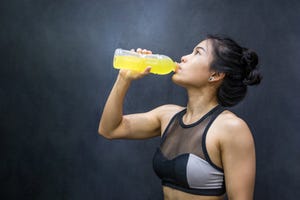Settle in, folks. Dr. Holly Lucille, David Winston, and others offer their takes.
.png?width=850&auto=webp&quality=95&format=jpg&disable=upscale)
One of the nice things about Supplement Perspectives is that it provides a forum. It’s not my space, but everybody’s. That’s what led to what you’re about to read.
Some topics cannot be addressed with the typical 450 to 500-word post. There will be times when industry folks will want to get long and lyrical and thorough. Delivery systems seemed like one of those topics where I could ask a few industry folk, “What do you recommend?” and “What would you pass on?” and then sit back and enjoy the show.
I did just that, and the answers I got back from the four participants—and, honestly, this is a starry group--were fantastic. (That’s why, with the exception of a few changes for clarity, I barely touched these answers. There’s no need to ruin a good thing.) Now, I’m not going to this every week, but I’m hoping I can do this once in a while for a change of pace.
This is considerably longer than most posts, so carve out a few minutes to savor the knowledge.
David Winston, RH (AHG), founder, Herbalist & Alchemist
The primary dosage forms for herbal medicine are teas (decoction or infusions) , tinctures (an alcohol and water extract), glycerin extracts (glycerites), capsules, gel caps, tablets, solid extracts and a few other less common forms like lozenges and gums. I would also note that capsules and tablets can contain powdered herbs, powdered extracts, or standardized extracts.
What is best to use really comes down to what is the most effective delivery method for a specific herb.
Slippery Elm works best taken as a tea. It is slimy and mucilaginous. That’s by far the best way of getting its medicinal activity. It’s available in lozenges or tablets but in my mind they don’t work nearly as well. And this is a case where a tincture doesn’t work at all.
If you’re talking about something like peppermint herb, a tea is the way to go, although a tincture or glycerite can work as well. For essential oil of peppermint, enteric-coated capsules would be the most effective form.
With chamomile, the simple tea works amazingly well. We know this because after Farmer McGregor almost killed Peter Rabbit his mother gave him chamomile tea. So it’s in the literature! You could also take a chamomile tincture, glycerite or a capsulated chamomile extract and they would all work, but it’s more expensive, and the time tested tea works very nicely. So some things work in multiple formats.
Ginkgo would be inert as a tea because the constituents are not water-soluble. The tincture has some activity, but all the research is on the standardized product. Ginkgo is not a traditional remedy, by the way. Ginkgo nuts were used in Traditional Chinese Medicine, but the leaf has almost no history of use. It was discovered in the 1960s or 1970’s during random screenings of plants looking for bioactive compounds. So this is a situation where you want a standardized, encapsulated product because that is the active and well-researched herbal medicine.
Mineral rich herbs are best micro-pulverized and put in capsules. Most tinctures (unless they are prepared by spagyric alchemical processes) contain low levels of minerals and while teas can extract minerals, they require long steeping (12 to 24 hours) which can also lead to high bacterial counts. There are herbs such as black pepper extract that can be added to capsules to aid in absorption.
If you ask me what my favorite delivery system is I would have to say either teas or tinctures. Liquids in general are better absorbed than tablets or capsules. Alcohol also enhances absorption by about 30 percent, A well-made tincture can be the most effective dosage form for many herbs such as Echinacea, fresh Oat, Skullcap, Cramp Bark or Corn Silk.
There are some drawbacks, particularly for people who have alcohol abuse issues (they should avoid tinctures). Some people are concerned about giving children alcohol, but the amount is so small that I am personally not concerned about that. Some tinctures can also taste really bad, but it’s easier to take 5 mLs, which is a teaspoon, of a nasty tasting tincture that you can chase with juice than it is four to eight ounces of a bitter tasting tea. For some people taste is a huge issue. If someone doesn’t like the taste of something they won’t take it, so pills and capsules are better for them, assuming they can swallow them. Ultimately it comes down to knowing the herb and knowing the person taking it.
Glycerin extracts (glycerites) work best for plants with water soluble constituents.
Due to the glycerin, they tend to have a sweet taste and so compliance is fairly high. Glycerin is not as good an extracting medium as alcohol and water, nor is it as good a preservative. Glycerin extracts are also milder than tinctures and need a larger dose.
In spite of these limitations a well made glycerite can be an effective preparation especially for children or people with alcohol abuse issues.
Solid extracts are less known. Most solid extracts are in a honey and glycerin base and somewhat viscous and sweet. Our solid extracts are very thick and made differently by a patented process. It can be a very effective way of getting an herb into a person. Because they taste good, compliance is very high. I think of solid extracts as medicinal foods. So for herbs like goji berry, pomegranate, cranberry, hawthorn and blueberry, it’s a wonderful way of making food your medicine and medicine your food.
One final thing to look at is cost. Teas are the least expensive, and then tinctures and glycerites. Proprietary extracts are the most costly preparations and for some people the cost is also a major issue.
Kathleen Dunn, MPH, RD, co-author of Eating for A’s and Supplement Perspectives contributor
Is there a delivery form for supplements that you would recommend most to a client looking for dietary advice?
Yes, especially for young school-aged kids. In Eating for A’s, my co-author and fellow registered dietitian and I encourage parents to give their child a high-quality multivitamin with iron and a DHA supplement, preferably at breakfast. However, supplements can’t nourish a child unless they take them. That’s where the delivery format becomes important. Even finicky kids are willing to make this a daily habit when high-quality supplements are delivered in appealing forms such as a fun-shaped chewable, squishy gummy, flavored liquid or gel, or sour tart. Once a parent finds their child’s favorite, it’s easier to transform this healthy behavior into a daily habit.
Is there one that you would be inclined to pass on?
As long as a supplement is high quality and meets a child’s needs, we don’t discourage any particular delivery form; however, some come with additional advice. These are supplements that combine acid (usually citric acid) and sugar, which can wreak havoc on tooth enamel. This is more common in fizzy or effervescent powders, tablets or liquids, but can also be found in other delivery forms. In this case, it’s especially important for a child to brush their teeth after taking supplements.
Neil E. Levin, CCN, Nutrition Education Manager, NOW Foods
NOW Foods is dedicated to providing products and services that enable people to live healthier lives. Regarding delivery systems, that means we work hard to offer a wide range of forms to suit various needs. It’s why we have a line of almost 1,000 supplement SKUs.
In order to vary our offerings to appeal to many different people and their different needs we offer both smaller and larger capsule sizes with appropriately varying recommendations for number of capsules per serving. We also provide some vegetarian-vegan friendly options. When appropriate, we offer chewables or liquids, enteric coated or delayed release, and fast release tablets.
For example, our extensive joint support supplement products line currently consists of some 50 SKUs. With the glucosamine-chondroitin products from that category, we offer them both singly and together, in sulfate and hydrochloride forms, some in combinations with MSM or trace minerals, and some in broader joint support formulas with other nutrients or botanicals. We offer four SKUs with vegetarian glucosamine, with and without MSM. In terms of delivery forms we offer tablets, gelatin capsules, Vcaps®, liquids, and powders.
Some are designed to take twice daily, others three times daily, and some four times daily to meet the needs of our customers who want to take larger/fewer or smaller/more pills. Some of the botanicals are also available singly, or via proteolytic enzymes like Bromelain, to offer still more choices outside of our joint support categories.
If a category warrants such proliferation of product forms we will provide those choices, thus making us more relevant as a consumer health resource that supports our retailers’ needs.
There are additional considerations we have to make when designing products, line extensions, and product improvements. As NOW is busy extending documentation to assure that all of our raw materials are non-GMO sourced, the greater use of Vcaps® over gelatin caps helps us to achieve that with relevant products since those capsules are now Non-GMO Project Verified. Additionally, with vegan capsules we can also better serve the large minority of health food shoppers who prefer vegetarian options. Some products contain gelatin or animal-sourced ingredients, so putting those ingredients into vegetarian capsules would be unnecessary and illogical, perhaps even confusing some vegetarian consumers.
Technical considerations also apply, such as knowing that Hyaluronic Acid (HA) has many receptors in the mouth, so to provide enhanced delivery we added a 100 mg vegetarian liquid formula with vitamins A-D-E and L-Proline to our existing 50 mg formula with MSM and 100 mg formula with L-Proline, ALA, and Grape Seed Extract (both in Vcaps®). Other important considerations include moisture and oxidation sensitivity that might restrict the use of powders, chewables, and uncoated tablets.
NOW carefully studies the materials and the market to design the best technically performing products in the widest range of delivery options that the market will support.
Holly Lucille, ND, RN, author and health advocate
It really all depends. I am not one of those practitioners with a bottom line on this. There are some ingredients that are better manufactured into a tablet, like a product called Osteoprime that I love. I prefer capsule form and use mostly those, but there are some exceptions. Then there is the issue of compliance. Some folks have a terrible time swallowing capsules or tablets, so they prefer liquid or powders. In cases where people have severely compromised digestion, I will do the liquids or powders, at first if I can, to start the healing because it is sort of pre-digested and spares the breakdown. Then there are folks who need high doses quick and IV is the best for them. What I tend to focus on more is the quality overall.
About the Author(s)
You May Also Like






.png?width=800&auto=webp&quality=80&disable=upscale)